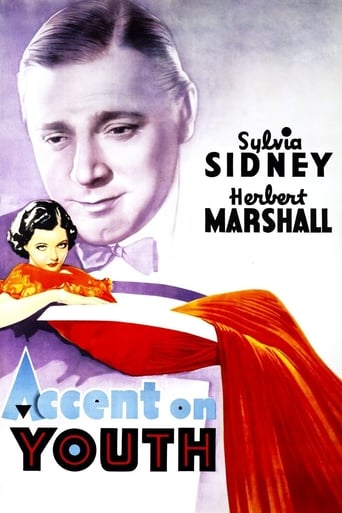winstonchurchill-93755
Herbert Marshsal could carry a script and Sylvia Sidney could stop a train with her eyes. Well written and well acted.
MartinHafer
Steven Gaye (Herbert Marshall) is a famous playwright who has just written a play about a May-December romance. However, as he works on the story, real life begins to intrude as the actress starring as the young lady in love with the older man, Linda (Sylvia Sidney), begins to actually fall in love with Steve. But Steve is a practical man and sees little future in this and encourages a young beau to pursue her as well. Sadly, when Steve and Linda get what they want, they don't seem to want it any more. What exactly does this mean? See the film.This is a mildly enjoyable old film that surprised me. The ending seems pretty much in line with Pre-Code sensibilities...so imagine my surprise when it turns out to be a Production Code movie...coming out the year following the implementation of the tough Production Code. Worth seeing and quite interesting, mostly because Marshall is great in most anything.
istara
It's hard to know what to make of "Accent on Youth". So many things happen in it that just seem odd to to the point of implausible.The basic plot is that:1. Secretary Linda is in love with her older boss, playwright Steven, who has been oblivious to her feelings. 2. An old girlfriend suddenly appears, Steven decides to retire and go off with her to Finland 3. He discharges Linda, who then declares her love for him. 4. Suddenly Steven un-retires and hires Linda to star in his new play. (No mention of how his old girlfriend takes this).Confused? That's only the start of this weird journey. The script ranges from melodrama through romance to sheer wincing awkwardness. It's at times arch, at other times pretentious, at other times simply implausible. "Hey! Let me look at you! Linda, you're strange, grand, lovely. No, no, no, don't go away. Let me look at you some more!" Even the legendary velvet tones of Herbert Marshall can't de-cringe this.Linda does the play. Then there's another mix-up, where Steven thinks young actor Dickie is involved with her. He storms home, Linda storms to his place, they have a row, and then they make up. They decide to get married. Perfect. Had the film ended here, it might have been reasonably pleasant and plausible.But wait, there's more...Dickie pops around and whinges to Steven. Steven clears out, Linda comes round, and in a few minutes is kissing Dickie passionately (bear in mind she's had every chance to do so before) and then marries him rather than Steven. What follows is a bizarre honeymoon where he spends all his time trying to get her to exercise, accompanied by his two friends. Although maybe there's a really obvious subtext here that I missed? There were presumably more than a few Hollywood marriages where the groom's "close friend" popped along for the ride.Anyway, Linda flees back to Steven and they end up together. Again. For what appears to be the third time in this bizarre story.Don't get me wrong, I loved this movie for all its absurdity. It has endless dialogue from Herbert Marshall for starters, which makes anything watchable/listenable.It's just hard to know how to take it. Bonus observation: the kissing by Herbert Marshall AWFUL, when kissing either Sylvia Sidney or Astrid Allwyn. (Sylvia does just fine with Phillip Reed/Dickie). I realise the Hay's Code had likely kicked in by the time this movie was released, but seriously. Check out the embrace about thirteen minutes in. "How was it?" Herbert Marshall asks. "Not bad!" Astrid Allwyn replies. No, Astrid. It was bad. It was very very very bad. Be glad you didn't end up going to Finland with him.
kevin olzak
1935's "Accent on Youth" was the first film adaptation of Samuel Raphaelson's 1934 Broadway play, the story of a wealthy 50 year old playwright, Steven Gaye (Herbert Marshall), whose latest offering, intended as a tragedy following 19 straight comedies, depicts a romance between a young woman and an older man. Yet for the previous three years, he has never noticed that his loyal young secretary, Linda Brown (Sylvia Sidney), has been in love with him. Life imitates art when Linda decides to marry her co-star in the play (Phillip Reed), much like her character does, but soon regrets the whirlwind decision. Rarely does the film leave Herbert Marshall's home, a static presentation that the cast tries hard to overcome. Among the smaller roles are Dick Foran and Lon Chaney, as Butch and Chuck, buddies of the young groom, who really only figure in the denouement. Foran was still billed as 'Nick Foran,' while this was one of the first films for Creighton Chaney's new moniker, 'Lon Chaney Jr.' Later versions include Bing Crosby in 1950's "Mr. Music" and Clark Gable in 1959's "But Not for Me."


